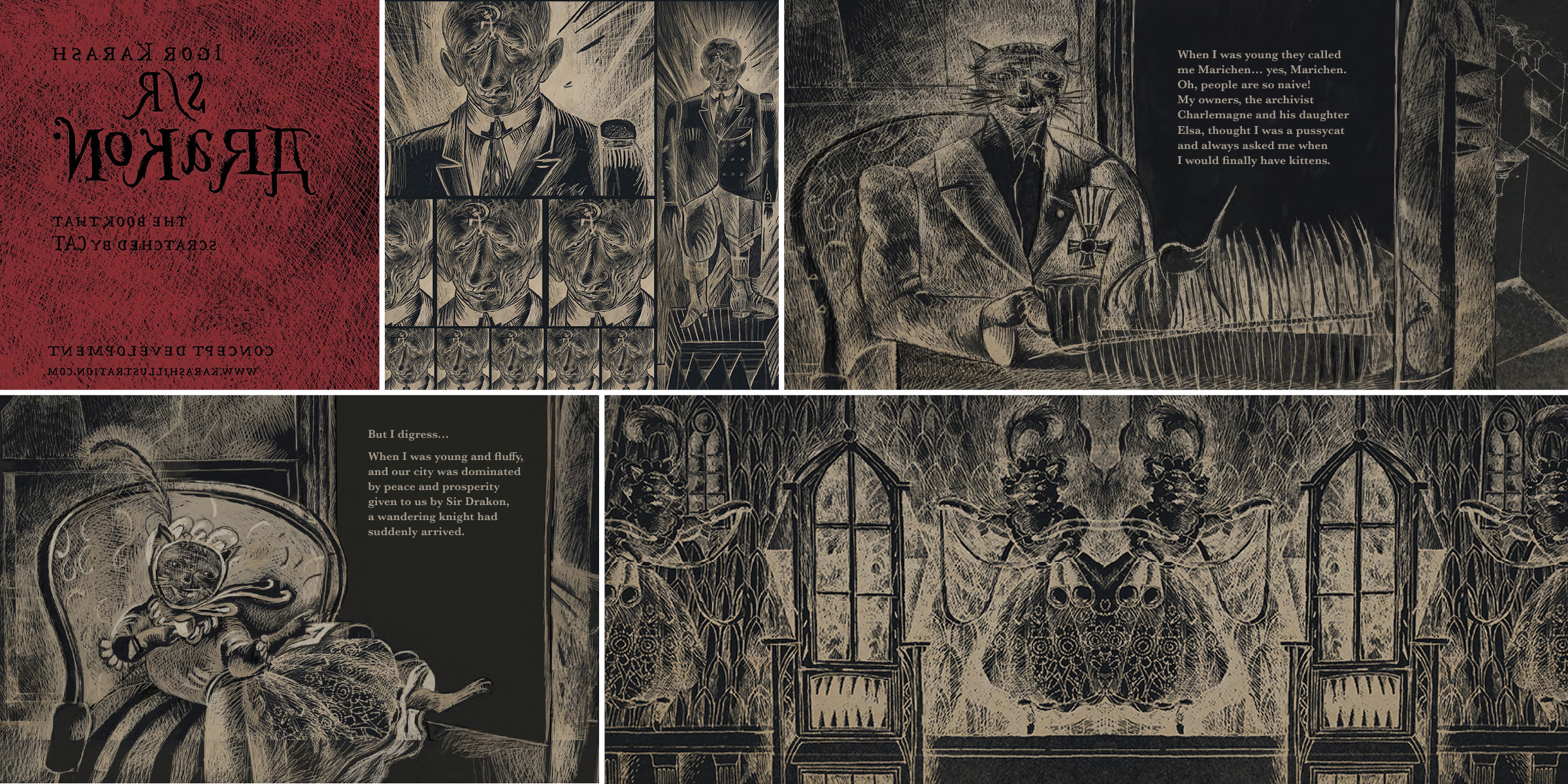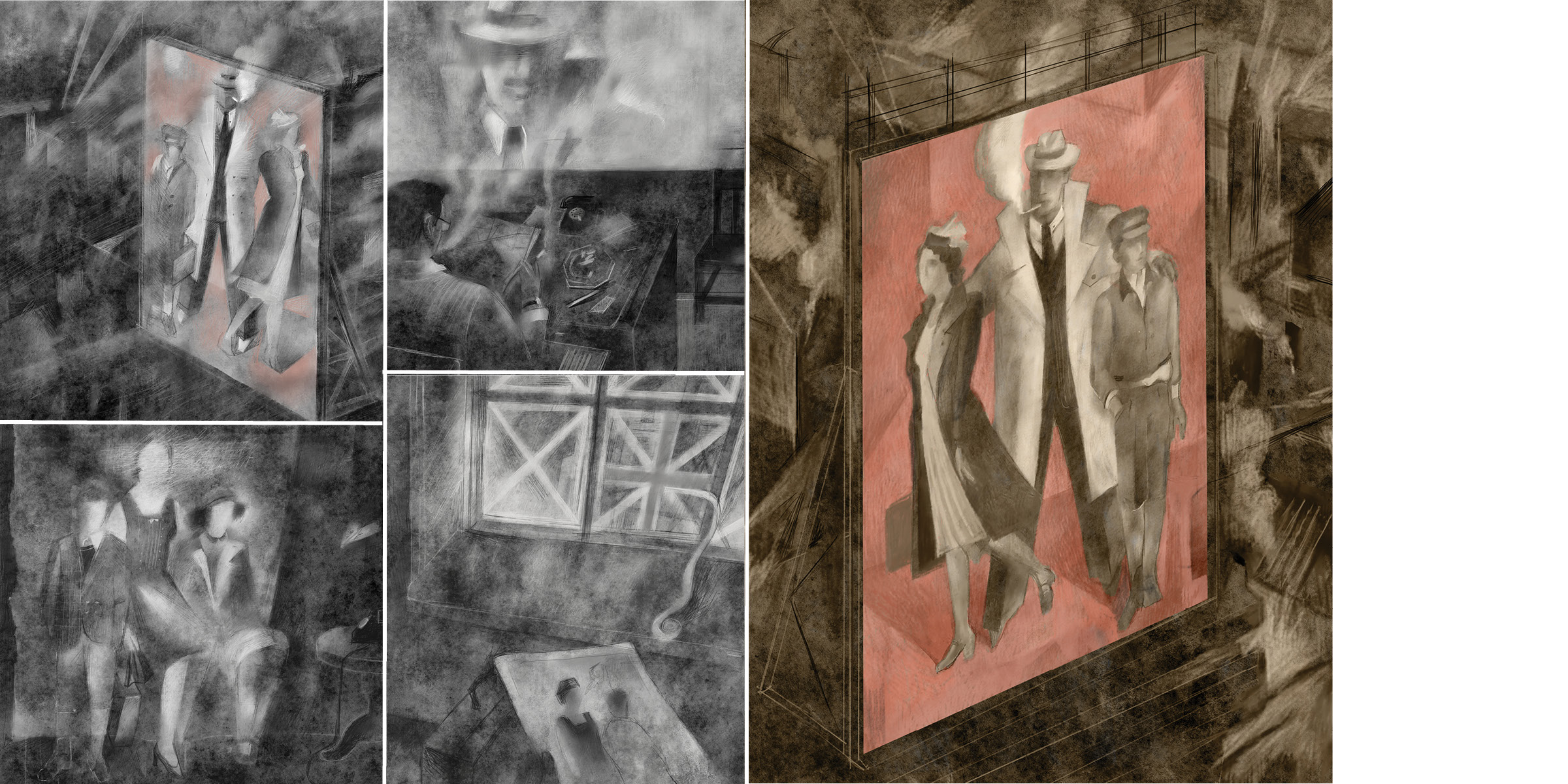We sat down with illustrator Igor Karash to discuss growing up in the Soviet Union and how soviet politics have influenced his work. We also discuss illustrating War & Peace, his latest children's book and much more.
Hi Igor, Thanks for taking the time out of your day to talk with us - we really enjoyed your ‘Postfolio’ that we have just viewed and learning about your influences and projects. Can you firstly give a brief introduction about who you are and what you do?
Hello! To begin with, I would like to thank Capsules Book for inviting me to this conversation. To answer your question, I grew up in Baku—the capital of the the former Soviet Republic of Azerbaijan.
I studied architecture in Baku for several years, and then continued my education in Ukraine at KSADA (Kharkov State Art and Design Academy) studying graphic design and illustration. When I try to write succinctly about myself it seems a bit trivial, but the truth is that very early in my development, I simply realized that I loved to draw… my ability to imagine and visualize things informed all of my educational and professional choices — I always followed my heart and intuition.
This approach had taken me down many paths… and I have found that I am most successful and creatively energized when drawing and illustration are integrated into my process. I have been fortunate to be able to apply myself to varying creative pursuits — book & editorial illustration, environmental graphics, graphic design, stage design, and to lend my knowledge to the next generation of illustrators as a professor.
You grew up in Baku, Azerbaijan but now currently reside in St. Louis, Missouri. When did you emigrate to the United States? What were your first impressions of the country?
My family and I immigrated to the United States in 1993. We landed in Houston, Texas, and that was quite an experience! Of course, it was very different from what we experienced living in the small provincial town of Kimry but it was also very different from our perception of ‘America’. People were much more open, friendlier than we could imagine, and it was much more diverse than we expected. It wasn’t an easy time — we had to learn the language, new customs, how to drive, etc. Our children had to adapt to the new environment, and we had to do it all in a very short time.
Of my many memories from that time, my only negative reaction was to the urban planning that is typical of most of American cities and that makes it very hard to move around if you have no means of transportation. I longed for the more European streets and city life that I enjoyed so much in my ‘previous’ life in Baku. I remember asking relatives and friends, “Where is the city?” When we finally got to see Houston’s downtown the scenery was quite surreal — a mind blowing sea of modernist and postmodern buildings and absolutely empty streets… that was the typical weekend scene in the business district in 1993. Things are a bit different now, and Saint Louis, where I live now, is much more compact and has more to offer in terms of a vibrant city life.
Do you ever travel back to visit Baku these days?
No, unfortunately only in my dreams, thoughts and memories—and of course through drawing and painting it once in a while. Baku, with its old inner city, unique character, narrow curvy streets, salty winds, and its stories and legends are part of who I am. I hope to visit my city again one day, but there are so many changes there (for better and for worse) that I am afraid I will not find the Baku of my dreams anymore.
You illustrated Leo Tolstoy’s War and Peace for the London Folio Society in 2014. Having grown up in the Soviet Union, how did it feel to be tasked to illustrate such an iconic piece of literature?
Well, it was an uneasy decision. I felt enormous pressure exactly for the reasons you just described. Not only is it an iconic piece of literature rich with imagery associated with historical events, figures, and characters established by generations of artists, illustrators and cinematographers—but it was also the colossal figure of Leo Tolstoy that stood over my shoulder.
In my country he is the patriarch of everything literary, philosophical, and cultural — so it was quite an overwhelming proposition. But I put on a brave face and took this once-in-a-lifetime opportunity to dive into the ‘river of life’ that is War & Peace.
War & Peace by Leo Tolstoy, Folio Society, London. Gouache on paper.
A little while ago, I wrote a post for the Folio Society blog which went into detail about many aspects of working on this book. If you or you readers are interested, you can find it by searching for The Weight of the War & Peace by Igor Karash.
War and Peace is a famously complex and detailed work, what challenges did you encounter whilst working on this project, and how did you overcome them?
The main challenge was to create illustrations that feel familiar, whilst presenting readers with a fresh interpretation of the text and to focus on portions of the text and nuances of the narrative which were perhaps overlooked in the past. I’m not sure if I was able to fully achieve this, but my true intent was to walk this very thin line between familiarity and novelty.
It was also a challenge to overcome my nervousness about the scale of this project and the weight of the imagery from previous adaptations of War & Peace in print and in film. Following my research process, I felt more and more comfortable setting aside this visual baggage and allowing for the great narrator Tolstoy and the amazing translator duo (Larissa Volokhonsky and Richard Pevear) to be my guides— allowing the emotion, colour, and hidden music of the text to inform my work.
Your projects have a beautiful detail and a darkness to them and your Red Series explores the theme of state control over the creative process. Is the current US and Russian political climate feeding into your latest body of work?
My Red Series is mostly triggered by the socio-political situation in Russia. It is impossible to distance myself from what is happening there. I grew up influenced by Russian artists and artistic movements, great literature and in a way am myself a product of its culture. But I cannot get my head around the fact that my country has squandered so many historical opportunities to become a democratic state.
I am looking for answers in the past, in the period of the February Revolution of 1917 followed by the Bolshevik coup in October of the same year, and the many tragic events which followed.
My work of course does not provide an objective historical account of the events, neither does it establishing the roles of leaders and participants. It is a purely artistic reflection in the form of intimate graphic narratives that border on the absurd.
Some pieces have literary associations — Gogol’s Nose is coming to Saint Petersburg in 1918, Bulgakov’s Professor Preobrazhensky turns into a monstrous dog, Lazik Roitshwantz becomes a wandering Jew, etc.
The current political climate in the US is quite worrisome, but there is hope. The American system is designed to correct itself to a certain degree — protecting basic democratic values. To me, the most important of them is the succession of power. On this account, Russia’s future appears particularly bleak.
Literature is clearly a huge influence on your work, so much so that you’ve written and illustrated your own children’s book, ‘Sir Dakon’. Could you tell us about what inspired you to create the story?
Sir Drakon, written and illustrated by Igor Karash. Ink and pen on cardboard, digital.
This work was inspired by the Soviet playwright Eugene Schwartz and his play “The Dragon” The original play was written after World War II as an anti-fascist pamphlet. However, many literary critics saw it as an anti-Stalinist farce as well. One day, drawing my fantasies about this play, I accidentally created the Cat character — a retired secret agent of the Loyalty Police, a cynical character who wears a medallion of honor for serving the motherland. At that very moment I decided to ask him to tell his story of the bygone days serving several rulers — the two-headed Sir Drakon (a democratically elected Head of the City) and the headless National Council of Justice. The idea of creating a new “Dragon” story came from observing the formation of Putin’s regime in modern day Russia. But this time my attempt is much more inclusive—I wanted to tell a tale for kids and their parents about the dangers of totalitarian regimes, dictatorial tendencies and false democracies. The book is almost complete, and I am currently looking for publishers interested in the project.
Your works have a beautiful painterly quality to them. It appears that you use a broad range of either traditional media, or a well curated selection of digital brushes to produce your works. Can you tell us a little more about your creative process and how you produce your artwork.
I am a traditionally trained artist, and never used any digital tools until the mid 90’s. Most of my work, including the two editions that were done for the Folio Society (The Bloody Chamber and Other Stories and War and Peace), as well as many theater set design projects and other illustration work are done using traditional media — watercolor and gouache on paper, acrylic on canvas, ink, mixed media, graphite, etc… Photoshop editing has always been very minimal.
Sketches and final illustration for the Oprah magazine Book Review. Digital.
With the rise of new technologies like artist tablets and digital brushes, on select projects I have found that I can keep my intuitive and improvisational mood and flow intact, still experiment with materials to establish an effective visual language. I am also very interested in incorporating some of my digital images into traditional media.
You earned a Masters degree in graphic art and illustration from Kharkov State Art & Design Academy Ukraine. If you could give yourself as a student any advice, what would it be?
I would advise my younger self to start establishing working/collaborative relations with people outside of academia while still in college. I was very shy and didn’t feel that I was ready for such collaboration. Secondly, I would suggest being more involved with hands-on processes inside the printing shop and lithographic studio to learn more about how to ‘build things’ and expand my knowledge of the technical aspects of creating art and design.
From the Black and Red Series. Digital.
What projects are you currently working on and what can we look forward to seeing from you in the future?
I am about to finalize the Sir Drakon book and will start sending my proposal to publishers.
Currently I am also planning to publish a collection of my Red Series as graphic album or a book project filled with drawings accompanied by quotes from newspapers from the Soviet Union of 1920’s.
I have an idea and some in-progress writing based on stories my grandmother told about her early days during the first years of the Soviet regime.
So... I’ll be busy drawing and telling my ‘Russian Story’.
Thank you for your time Igor, it was a pleasure to talk with you.
Thank you so much, I really appreciate this opportunity to discuss my work with you and thanks for everything you do to promote the art of illustration!
To find out more about Igor Karash, and his artwork, please visit: karashillustration.com

















